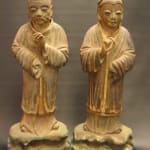A Ming Dynasty Painted Stucco Couple, 1368 CE - 1644 CE
Stucco
28 x 28.5
DL.2070
Further images
Upon leading a victorious rebellion against the foreign Mongul rulers of the Yuan Dynasty, a peasant named Zhu Yuanzhang seized control of China and founded the Ming Dynasty in 1368....
Upon leading a victorious rebellion against the foreign Mongul rulers of the Yuan Dynasty, a peasant named Zhu Yuanzhang seized control of China and founded the Ming Dynasty in 1368. As emperor, he founded his capital at Nanjing and adopted the name Hongwu as his reign title. Hongwu, literally meaning “vast military,” reflects the increased prestige of the army during the Ming Dynasty. Culturally, the greatest innovation of the Ming Dynasty was the introduction of the novel. Developed from the folk tales of traditional storytellers, these works were transcribed in the everyday vernacular language of the people. Advances in printmaking and the increasing population of urban dwellers largely contributed to the success of these books. Architecturally, the most famous monument of the Ming Dynasty is surely the complex of temples and palaces known as the Forbidden City that was constructed in Beijing after the third ruler of the Ming Dynasty, Emperor Yongle, moved the capital there. Today, the Forbidden Palace remains one of the hallmarks of traditional Chinese architecture and is one of the most popular tourist destinations in the vast nation.
This delightful couple are an important testament to the artistic achievements of the Ming Dynasty. Standing on two sculpted bases, both figures perform the same gestures, with one hand raised and the other hidden within the sleeve of their long gowns. A small round object survives between the thumb and forefinger of the female and it is likely that the man once held a similar item. Considerable traces of the original polychromy remain and remind us that these figures would once have been alive with colour. The outer robes were dark blue, worn over a red undergarment. The hairstyles are traditional and the attention to detail is nowhere more apparent than in the expertly fashioned hairpin worn by the female. The deep furrows on the man’s forehead suggest wisdom and old age, while the female has a more youthful appearance.
This delightful couple are an important testament to the artistic achievements of the Ming Dynasty. Standing on two sculpted bases, both figures perform the same gestures, with one hand raised and the other hidden within the sleeve of their long gowns. A small round object survives between the thumb and forefinger of the female and it is likely that the man once held a similar item. Considerable traces of the original polychromy remain and remind us that these figures would once have been alive with colour. The outer robes were dark blue, worn over a red undergarment. The hairstyles are traditional and the attention to detail is nowhere more apparent than in the expertly fashioned hairpin worn by the female. The deep furrows on the man’s forehead suggest wisdom and old age, while the female has a more youthful appearance.





